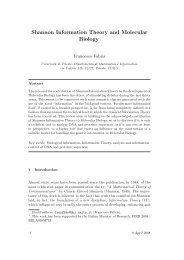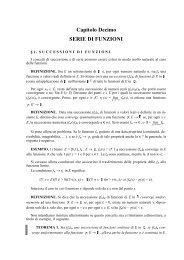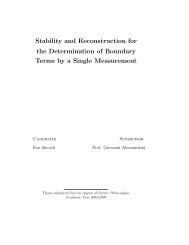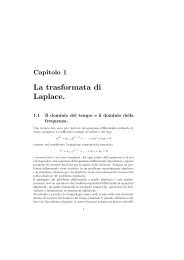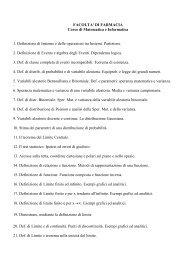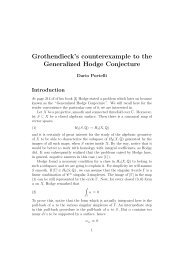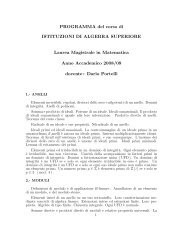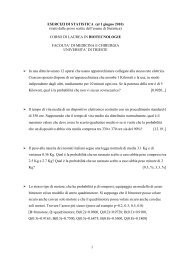INTRODUCTION TO ALGEBRAIC GEOMETRY Note del corso di ...
INTRODUCTION TO ALGEBRAIC GEOMETRY Note del corso di ...
INTRODUCTION TO ALGEBRAIC GEOMETRY Note del corso di ...
You also want an ePaper? Increase the reach of your titles
YUMPU automatically turns print PDFs into web optimized ePapers that Google loves.
12 Mezzetti3.1. Proposition. Let K be an algebraically closed field. Let Z ⊂ P n be aprojective hypersurface of degree d. Then a line of P n , not contained in Z, meetsZ at exactly d points, counting multiplicities.Proof. Let G be the reduced equation of Z and L ⊂ P n be any line.We fix two points on L: A = [a 0 , . . ., a n ], B = [b 0 , . . ., b n ]. So L admitsparametric equations of the form⎧x 0 = λa 0 + µb 0⎪⎨x 1 = λa 1 + µb 1⎪⎩ . . .x n = λa n + µb nThe points of Z ∩L are obtained from the homogeneous pairs [λ, µ] which aresolutions of the equation G(λa 0 + µb 0 , . . ., λa n + µb n ) = 0. If L ⊂ Z, then thisequation is identical. Otherwise, G(λa 0 + µb 0 , . . ., λa n + µb n ) is a non-zero homogeneouspolynomial of degree d in two variables. Being K algebraically closed, itcan be factorized in linear factors:G(λa 0 + µb 0 , . . ., λa n + µb n ) = (µ 1 λ − λ 1 µ) d 1(µ 2 λ − λ 2 µ) d 2. . .(µ r λ − λ r µ) d rwith d 1 + d 2 + . . . + d r = d. Every factor corresponds to a point in Z ∩ L, to becounted with the same multiplicity as the factor.□If K is not algebraically closed, considering the algebraic closure of K andusing Proposition 3.1, we get that d is un upper bound on the number of pointsof Z ∩ L.c) Affine and projective subspaces.The subspaces introduced in §1, both in the affine and in the projective case,are examples of algebraic sets.d) Product of affine spaces.Let A n , A m be two affine spaces over the field K. The cartesian productA n ×A m is the set of pairs (P, Q), P ∈ A n , Q ∈ A m : it is in natural bijection withA n+m via the mapφ : A n × A m −→ A n+msuch that φ((a 1 , . . ., a n ), (b 1 , . . ., b m )) = (a 1 , . . ., a n , b 1 , . . ., b m ).From now on we will always identify A n × A m with A n+m . We get twotopologies on A n × A m : the Zariski topology and the product topology.3.1. Proposition. The Zariski topology is strictly finer than the product topology.Proof. If X = V (α) ⊂ A n , α ⊂ K[x 1 , . . ., x n ] and Y = V (β) ⊂ A m , β ⊂K[y 1 , . . ., y m ], then X × Y ⊂ A n × A m is Zariski closed, precisely X × Y =



